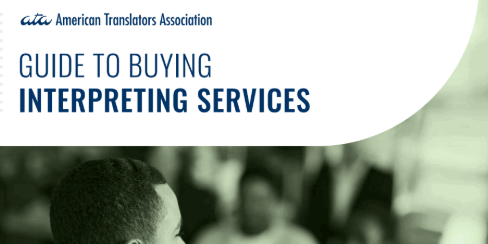Guide to Buying Interpreting Services, Part IV: ATA’s Credentialed Interpreter (CI) Designation

ATA’s Language Services Directory has a Credentialed Interpreter (CI) designation to indicate ATA members who are also credentialed interpreters. This designation is discussed in more detail below. To find out more about interpreting, refer to the American Translators Association’s Guide to Buying Interpreting Services, a resource to help clients identify, select and work with interpreters.
Credentialed Interpreter (CI) Designation
The Credentialed Interpreter (CI) designation shown in ATA’s Language Services Directory recognizes interpreters who are credentialed by certain ATA-approved entities in fields such as medical, legal and conference interpreting.

Proven Competency
ATA members who hold a CI designation have demonstrated linguistic competence, oral proficiency and a commitment to continuous professional development.
Approved Entities
The CI designation is not a certification. Rather, the credentialed interpreter designation in ATA’s Language Services Directory acknowledges interpreters who are recognized by certain ATA-approved entities in fields such as medical legal conference interpreting.
Easy to Identify
ATA Credentialed Interpreters are clearly identified in the Language Services Directory.
Requirements for the CI Designation
- Proficiency
Interpreters must demonstrate proficiency by:
- passing an oral exam that tests performance skills in two or more modes of interpreting, with published assessment instruments, research methods, development and validation procedures and eligibility requirements, or
- for conference interpreting, undergoing exacting peer review or testing through one of the organizations approved by ATA for the CI designation, or
- passing a monolingual oral exam that tests performance skills in two or more modes of interpreting, with requirements similar to the above as well as a prerequisite minimum language proficiency requirement for the untested language.
- The credential must be granted by:
- A government agency, or
- A non-profit professional association, or
- A non-profit certification board or governing committee that meets specific criteria.
Additional ATA Resources
This is the fourth article in a series of articles introducing the American Translators Association’s Guide to Buying Interpreting Services, which was created to help those in need of interpreting services find the best provider for their project and work efficiently with the chosen interpreting provider. For the full guide, click here.
About the Authors
Eve Bodeux is an ATA-certified French to English translator specialized in tech marketing, commercial communications, marketing research and official documents. She is the Secretary of the American Translators Association and serves on the ATA Public Relations Committee.
Jamie Hartz is an ATA-certified Spanish to English translator and transcriber specialized in legal and commercial translations. She currently serves as the Chair of the ATA Public Relations Committee.
Language Services Directory
Subscribe to The ATA Compass
Connect with The ATA Compass
Recent Posts
Translator vs. Interpreter
Watch a Day in the Life of Translators and Interpreters See how translators and interpreters work in this short animated video. Translators do the writing Translators work with the written…
Read MoreWhy You Should Use a Certified Translator or Interpreter
Choosing a Certified Professional is the Smart Choice A certified translator or interpreter ensures effective, accurate, and culturally sensitive communication that truly bridges the gap between languages and cultures. Accuracy…
Read MoreWhat is a Certified Translation?
What are the basics of a certified translation? In the United States, anyone can certify a translation. A translator does not need to be certified in order to provide a…
Read MoreExploring Translation and Interpreting Services
Why Are Language Services Essential in an Internationalized World? In a world where communication knows no bounds, effective language services are paramount. ATA helps you find professional translators and interpreters…
Read MoreKnow Your Rights to Language Access
Is English Not Your Primary Language? If you have a limited ability to read, write, speak, or understand English, you are considered to be Limited English Proficient (LEP). As an…
Read MoreMachine Translation
What is machine translation? Machine translation (MT) is the use of automated software that translates text without human involvement. Adaptive MT is a technology that learns and adjusts in real-time…
Read More






